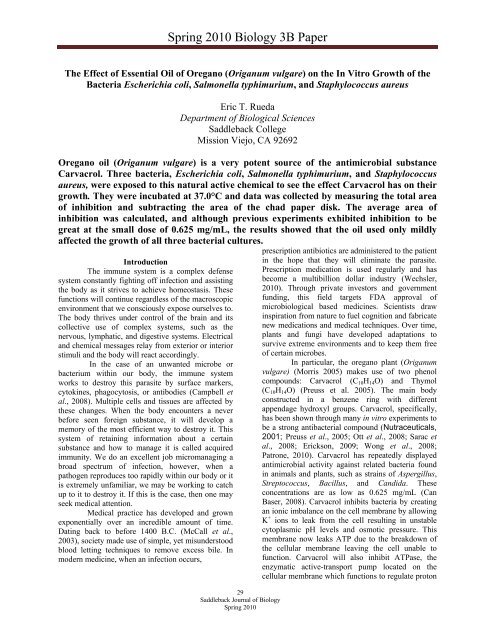Saddleback Journal of Biology - Saddleback College
Saddleback Journal of Biology - Saddleback College
Saddleback Journal of Biology - Saddleback College
You also want an ePaper? Increase the reach of your titles
YUMPU automatically turns print PDFs into web optimized ePapers that Google loves.
Spring 2010 <strong>Biology</strong> 3B Paper<br />
The Effect <strong>of</strong> Essential Oil <strong>of</strong> Oregano (Origanum vulgare) on the In Vitro Growth <strong>of</strong> the<br />
Bacteria Escherichia coli, Salmonella typhimurium, and Staphylococcus aureus<br />
Eric T. Rueda<br />
Department <strong>of</strong> Biological Sciences<br />
<strong>Saddleback</strong> <strong>College</strong><br />
Mission Viejo, CA 92692<br />
Oregano oil (Origanum vulgare) is a very potent source <strong>of</strong> the antimicrobial substance<br />
Carvacrol. Three bacteria, Escherichia coli, Salmonella typhimurium, and Staphylococcus<br />
aureus, were exposed to this natural active chemical to see the effect Carvacrol has on their<br />
growth. They were incubated at 37.0°C and data was collected by measuring the total area<br />
<strong>of</strong> inhibition and subtracting the area <strong>of</strong> the chad paper disk. The average area <strong>of</strong><br />
inhibition was calculated, and although previous experiments exhibited inhibition to be<br />
great at the small dose <strong>of</strong> 0.625 mg/mL, the results showed that the oil used only mildly<br />
affected the growth <strong>of</strong> all three bacterial cultures.<br />
Introduction<br />
The immune system is a complex defense<br />
system constantly fighting <strong>of</strong>f infection and assisting<br />
the body as it strives to achieve homeostasis. These<br />
functions will continue regardless <strong>of</strong> the macroscopic<br />
environment that we consciously expose ourselves to.<br />
The body thrives under control <strong>of</strong> the brain and its<br />
collective use <strong>of</strong> complex systems, such as the<br />
nervous, lymphatic, and digestive systems. Electrical<br />
and chemical messages relay from exterior or interior<br />
stimuli and the body will react accordingly.<br />
In the case <strong>of</strong> an unwanted microbe or<br />
bacterium within our body, the immune system<br />
works to destroy this parasite by surface markers,<br />
cytokines, phagocytosis, or antibodies (Campbell et<br />
al., 2008). Multiple cells and tissues are affected by<br />
these changes. When the body encounters a never<br />
before seen foreign substance, it will develop a<br />
memory <strong>of</strong> the most efficient way to destroy it. This<br />
system <strong>of</strong> retaining information about a certain<br />
substance and how to manage it is called acquired<br />
immunity. We do an excellent job micromanaging a<br />
broad spectrum <strong>of</strong> infection, however, when a<br />
pathogen reproduces too rapidly within our body or it<br />
is extremely unfamiliar, we may be working to catch<br />
up to it to destroy it. If this is the case, then one may<br />
seek medical attention.<br />
Medical practice has developed and grown<br />
exponentially over an incredible amount <strong>of</strong> time.<br />
Dating back to before 1400 B.C. (McCall et al.,<br />
2003), society made use <strong>of</strong> simple, yet misunderstood<br />
blood letting techniques to remove excess bile. In<br />
modern medicine, when an infection occurs,<br />
29<br />
<strong>Saddleback</strong> <strong>Journal</strong> <strong>of</strong> <strong>Biology</strong><br />
Spring 2010<br />
prescription antibiotics are administered to the patient<br />
in the hope that they will eliminate the parasite.<br />
Prescription medication is used regularly and has<br />
become a multibillion dollar industry (Wechsler,<br />
2010). Through private investors and government<br />
funding, this field targets FDA approval <strong>of</strong><br />
microbiological based medicines. Scientists draw<br />
inspiration from nature to fuel cognition and fabricate<br />
new medications and medical techniques. Over time,<br />
plants and fungi have developed adaptations to<br />
survive extreme environments and to keep them free<br />
<strong>of</strong> certain microbes.<br />
In particular, the oregano plant (Origanum<br />
vulgare) (Morris 2005) makes use <strong>of</strong> two phenol<br />
compounds: Carvacrol (C 10 H 14 O) and Thymol<br />
(C 10 H 14 O) (Preuss et al. 2005). The main body<br />
constructed in a benzene ring with different<br />
appendage hydroxyl groups. Carvacrol, specifically,<br />
has been shown through many in vitro experiments to<br />
be a strong antibacterial compound (Nutraceuticals,<br />
2001; Preuss et al., 2005; Ott et al., 2008; Sarac et<br />
al., 2008; Erickson, 2009; Wong et al., 2008;<br />
Patrone, 2010). Carvacrol has repeatedly displayed<br />
antimicrobial activity against related bacteria found<br />
in animals and plants, such as strains <strong>of</strong> Aspergillus,<br />
Streptococcus, Bacillus, and Candida. These<br />
concentrations are as low as 0.625 mg/mL (Can<br />
Baser, 2008). Carvacrol inhibits bacteria by creating<br />
an ionic imbalance on the cell membrane by allowing<br />
K + ions to leak from the cell resulting in unstable<br />
cytoplasmic pH levels and osmotic pressure. This<br />
membrane now leaks ATP due to the breakdown <strong>of</strong><br />
the cellular membrane leaving the cell unable to<br />
function. Carvacrol will also inhibit ATPase, the<br />
enzymatic active-transport pump located on the<br />
cellular membrane which functions to regulate proton

















